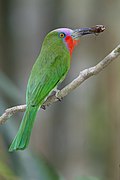Nyctyornis
| Nyctyornis | |
|---|---|

| |
| Blue-bearded bee-eater (Nyctyornis athertoni) | |
| Scientific classification | |
| Domain: | Eukaryota |
| Kingdom: | Animalia |
| Phylum: | Chordata |
| Class: | Aves |
| Order: | Coraciiformes |
| Family: | Meropidae |
| Genus: | Nyctyornis Jardine & Selby, 1830 |
| Type species | |
| Merops amictus[1] Temminck, 1824
| |
| Species | |
|
See text | |
Nyctyornis is a genus of the bee-eaters, near passerine birds in the family Meropidae. There are just two members of this group, which occur in tropical south and southeastern Asia.[2]
| Image | Scientific name | Common Name | Distribution |
|---|---|---|---|
 |
Nyctyornis amictus | Red-bearded bee-eater | Southeast Asia |
 |
Nyctyornis athertoni | Blue-bearded bee-eater | Indian subcontinent and parts of Southeast Asia |
The genus Nyctyornis was introduced by the naturalists William Jardine and Prideaux John Selby in 1830.[3][4] The name comes from the Ancient Greek nukt meaning nocturnal or night and ornis meaning bird.[5] A molecular phylogenetic study published in 2007 showed that the genus is basal and forms a sister group to the remaining members of the bee-eater family.[6]
Like other bee-eaters, Nyctyornis species are colourful birds with long tails, long downturned bills and pointed wings. They are large bee-eaters (blue-bearded is the largest of all bee-eaters),[7] predominantly green, with a face colour as indicated by the species' name. This colour extends on to the slightly hanging throat feathers to form the "beard".[8]
The two Nyctyornis species are the only bee-eaters that lack an eye-stripe and that have bi-coloured beaks.[6] Their calls also differ from those of other bee-eaters and are somewhat similar to the noises made by rollers.[9] Their size and more rounded wings give a heavier flapping flight that is less graceful than that of members of the genus Merops.[9]
In common with other bee-eaters, they predominantly eat insects, especially bees, wasps and hornets, which are caught in the air, but they have a rather different strategy. They hunt alone or in pairs, rather than in groups, and sit motionless for long periods before pursuing their prey.[9] The blue-bearded bee-eater will also clamber in foliage for insects, and bees are sometimes attracted by the bright blue beard of a perched bird, presumably mistaking it for a flower.[10] They nest in burrows tunneled into the side of sandy banks, but do not form colonies.[11]
References
[edit]- ^ "Momotidae". aviansystematics.org. The Trust for Avian Systematics. Retrieved 2023-07-25.
- ^ Gill, Frank; Donsker, David, eds. (2016). "Todies, motmots, bee-eaters, hoopoes, wood hoopoes & hornbills". World Bird List Version 6.4. International Ornithologists' Union. Retrieved 23 October 2016.
- ^ Peters, James Lee, ed. (1945). Check-list of Birds of the World. Volume 5. Cambridge, Massachusetts: Harvard University Press. p. 238.
- ^ Jardine, William; Selby, Prideaux John (1830). Illustrations of Ornithology. Vol. 2. Edinburgh: W.H. Lizars. Addenda.
- ^ Jobling, James A. (2010). The Helm Dictionary of Scientific Bird Names. London: Christopher Helm. p. 277. ISBN 978-1-4081-2501-4.
- ^ a b Marks, B.D.; Weckstein, J.D.; Moyle, R.G. (2007). "Molecular phylogenetics of the bee-eaters (Aves: Meropidae) based on nuclear and mitochondrial DNA sequence data". Molecular Phylogenetics and Evolution. 45 (1): 23–32. Bibcode:2007MolPE..45...23M. doi:10.1016/j.ympev.2007.07.004. PMID 17716922.
- ^ Fry, Fry & Harris 1992, p. 242.
- ^ Fry, Fry & Harris 1992, pp. 241–244.
- ^ a b c Fry, Hilary (2001). "Family Meropidae (Bee-eaters)". In del Hoyo, J.; Elliott, A.; Sargatal, J. (eds.). Handbook of the Birds of the World. Vol. 6: Mousebirds to Hornbills. Barcelona, Spain: Lynx Edicions. pp. 286–325. ISBN 978-84-87334-30-6.
- ^ Fry, Fry & Harris 1992, p. 243.
- ^ Fry, Fry & Harris 1992, pp. 242, 244.
Sources
[edit]- Fry, C. Hilary; Fry, Kathie; Harris, Alan (1992). Kingfishers, Bee-eaters, and Rollers. London: Christopher Helm. ISBN 978-0-7136-8028-7.








